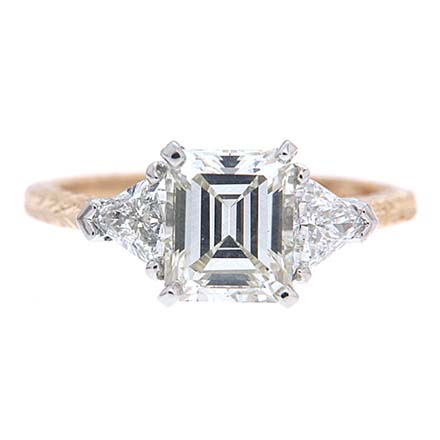While a number of people find a single jewel on their diamond engagement ring to be all the shine they need, others enjoy some extra brightness. For the latter, side stone diamonds may be just the enhancement their looking for. In  addition to the brilliance and luster they provide, rings with three stones symbolize the past present and future of a relationship.
addition to the brilliance and luster they provide, rings with three stones symbolize the past present and future of a relationship.
Three stone rings usually have side stones that differentiate from the center jewel. All three may be of the same cut, with the flanking jewels a smaller size. An alternative idea are side stones of a different shape from the central jewel. Triangular diamonds are popular for this purpose, as are pear shaped stones. Those who want something a bit more uncommon might want to consider marquise cut diamonds to flank their main jewel.
Some designers add yet more shine to their diamond engagement rings by mounting additional stones onto the band. Five or seven diamonds of uniform cut and similar or graduated sizes may be mounted side by side, or there may be enough diamonds to circle the entire band. Round brilliant cut diamonds are most common for this style, though other cuts such as the princess cut diamond are used. Another popular variation on side stones is to use tiny diamonds to cover parts of or the entire band in a technique known as pave.
Accents for Your Ring
Most diamond bands have a jewel which serves as the ring’s focal point. Solitaire rings feature just this stone. Other bands are decorated with still more jewels. Those which sit on the left and right of the central diamond are known as side stones.
One common side stone is the baguette. This cut is long and thin, reminiscent of a loaf of bread. The gem is cut small and often mounted to accent other jewels. Baguettes come on two varieties, one which is rectangular and another with tapered sides. Both are used in rings, and are usually set lengthwise along the band.
Triangular diamonds also come in two varieties. Step cut stones focus on luster and the clarity of the jewels. Brilliant versions add more sparkle to the ring. Most triangle side stones are set with a flat edge resting against the central diamond.
Shield shaped diamonds are five sided jewels which resemble a kite with a tip removed. The cut can be either brilliant or step. The shape can also change, with straight lines or gently curved sides. When mounted on diamond rings, the tips often face away from the central stone.
Pear shaped diamonds are elongated jewels with one round end and one pointed. When they’re mounted as side stones, they’re often mounted with the points facing away from the central gem. Other rings may have the diamonds pointed towards the fingertip to lengthen the hand.
Marquise diamonds are oval with pointed tips. They should be symmetrical, with gently curved sides and defined points. These diamonds make the hand look longer and slimmer, adding to their appeal. As side stones, they can be mounted with their tips pointing down the band or along the finger.
Baguette Diamonds
The baguette cut diamond has a narrow rectangular shape, akin to the skinny French bread. Like the emerald cut, and Asscher cut, the baguette cut is designed to display the diamond’s color, polish and clarity. Unlike the other two, the baguette is most popular in modern times as an accent for other jewels, particularly when it comes to flanking the central stone in a ring.
During the Art Deco period, the baguette cut’s geometric shape combined with its versatility as a building block in elaborate designs made it a popular shape. Baguettes are still a common element in Art Deco influenced jewelry.
Diamond side stones allow wearers to further customize their rings. Those who enjoy the look of matching stones can have a row of the same cut. People who want to mix outlines, step and brilliant cuts can play with shape and sparkle. The end result should be diamond rings one is happy to wear.





